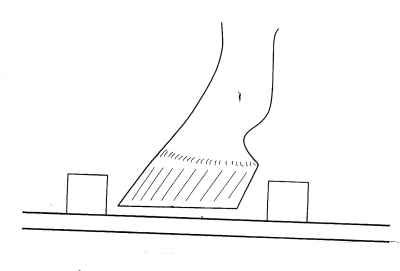 |
This is the correct cleat spacing for all livestock. The cleats should be spaced so that the hooves fit easily between them (from Grandin, 2008) |
 |
This is the correct cleat spacing for all livestock. The cleats should be spaced so that the hooves fit easily between them (from Grandin, 2008) |
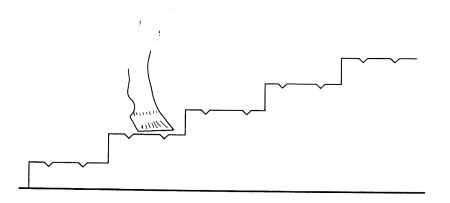 |
When a loading ramp is constructed from concrete, stair steps are recommended. The steps should have a 10cm rise and a 30-60 cm tread length. Do not exceed a 10 cm rise. The minimum tread length is 30 cm. The steps must be grooved to provde non-slip footing. These dimensions are recommended for cattel, water buffalo, horses, and other large animals. For pigs, a smaller 8 cm rise is recommended (from Grandin, 2008) |
The angle of the loading ramp must not be too steep. For best results, the anlge of hte ramp should not exceed 20 degrees. The best way to evaluate the performance of both people an equipment during loading or unloadin ganimals is to use objective numerical scoring. Some of the variables that should be measured are:
Grandin, T. (2008). Engineering and design of holding yards, loadin gramps, and handling facilities for land/sea transport of livestock. Veterinaria Italiana. 44:235-245.
Grandin, T. (2010). Welfare during transport of livestock and poultry, in T. Grandin (editor) Improving Animal Welfare: A Practical Approach. CABI Publishing. pp. 115-138.
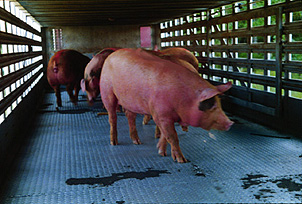
Trailers should be kept in good repair. To comply with environmental regulations, truck floors should be leak-proof to prevent urine and manure from dripping onto the highway. With today's modern, taller cattle, it is essential that semi-trailers have sufficient height between decks to prevent back injuries. Overloading of trucks will increase bruising. In one survey, overloading two extra head of cattle increased bruising. When trucks are overloaded with cattle, it becomes impossible for a downed animal to get up. This will result in the animal being trampled and severly bruised. Overloading of pig trucks will increase death losses and PSE. To prevent skin blemishes, pig trucks should be cleaned after each load.
When the temperature is over 60 degrees F (15 C), use wet sand or wet shavings to keep pigs cool. If the temperature is over 80 degrees F (27 C), sprinkle pigs with water prior to loading at buying stations or on the farm. Never bed pigs with straw during hot weather. When the temperature is below 60 degrees F (15 C), bed pigs with straw or deep, dry shavings to keep them warm. In the northern regions, approximately half of the air holes in aluminum trailers transporting pigs should be covered with plywood when the temperature drops to 10 degrees F (-12 C). Click here for article on transport of pigs.
Veal calves can require special care in transport because they are so young. Take care in cooler temperatures, below 60 degrees F (15 C), to provide straw bedding and plug some air holes in trucks so the calves do not become too cold.
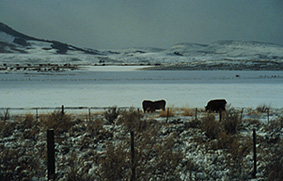
People trucking and handling animals need to understand both wind chill factors and heat stress. Wind chill can kill livestock. Wetting the haircoat on cattle destroys its ability to insulate the animal's body. Death losses in cattle are often greatest when the temperatures are near freezing and either rain or freezing rain blows into a truck. Dry, cold weather is less hazardous to cattle because the coat retains its ability to insulate. Wind chill can make the back of a trailer very cold. When a truck is moving 50 mph on a 20-degree F (-7 C) day, the wind chill factor for pigs is minus 23 degrees F (-31 C).
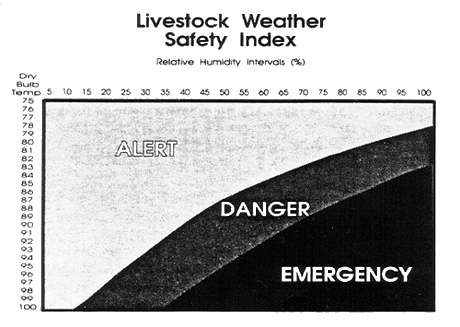
The combination of high temperature and humidity is especially detrimental for pigs. When the Livestock Weather Safety Index is in the Danger and Emergency zone, try to schedule pig shipments for the early morning. If this is not possible, trucks should be kept moving and drivers should not be allowed to stop at the coffee shop with a loaded trailer. When the trucks reach the plant, they must be unloaded promptly.
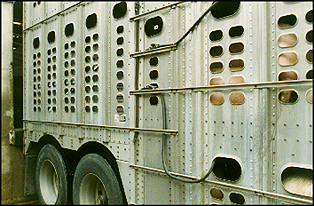
Truck with ventilation holes open for transporting pigs during hot weather. The hoses leading into the vehicle are used to wet the pigs. Pigs should be wetted with a coarse spray and then the water should be turned off to allow them to cool by evaporation. Fine mist should NOT be used. A coarse heavy spray provided better cooling than a fine mist.
| Feedlot Fed Steers or Cows, Avg. Weight English / Metric Units |
Horned or Tipped or more than 10% Horned and Tipped English / Metric Units |
No Horns (polled) English / Metric Units |
|---|---|---|
| 800 lbs ( 360 kg ) | 10.90 sq.ft. (1.01 sq.m) | 10.40 sq.ft. (0.97 sq.m.) |
| 800 lbs (360 kg ) | 10.90 sq.ft. (1.01 sq.m) | 10.40 sq.ft. (0.97 sq.m.) |
| 1000 lbs ( 454 kg) | 12.80 sq.ft. (1.20 sq.m) | 12.00 sq.ft. (1.11 sq.m.) |
| 1200 lbs ( 545 kg) | 15.30 sq.ft. (1.42 sq.m) | 14.50 sq.ft. (1.35 sq.m.) |
| 1400 lbs (635 kg) | 19.00 sq.ft. (1.76 sq.m) | 18.00 sq.ft. (1.67 sq.m.) |
| Market Weight Pigs English / Metric Units |
Winter English / Metric Units |
Summer temp.75+ degrees F (24C) English / Metric Units |
| 200 lbs. ( 90 kg ) | 3.50 sq.ft. ( 0.32 sq.m.) | 4.00 sq.ft. ( 0.37 sq.m.) |
| 250 lbs. ( 113 kg ) | 4.26 sq.ft. ( 0.40 sq.m.) | 5.00 sq.ft. ( 0.46 sq.m.) |
| Slaughter Weight Lambs and Sheep English / Metric Units |
Shorn English / Metric Units |
Full Fleece English / Metric Units |
| 60 lbs. ( 27 kg ) | 2.13 sq.ft. ( 0.20 sq.m.) | 2.24 sq.ft. ( 0.21 sq.m.) |
| 80 lbs. ( 36 kg ) | 2.50 sq.ft. ( 0.23 sq.m.) | 2.60 sq.ft. ( 0.24 sq.m.) |
| 100 lbs. ( 45 kg ) | 2.80 sq.ft. ( 0.26 sq.m.) | 2.95 sq.ft. ( 0.27 sq.m.) |
| 120 lbs. ( 54 kg ) | 3.20 sq.ft. ( 0.30 sq.m.) | 3.36 sq.ft. ( 0.31 sq.m.) |
Pigs transported for a few hours can remain standing, but pigs transported long distances need enough space to lie down. Research conducted by the Prairie Swine Center in 2013 indicated that after on hour of transport, 70 to 80% of the pigs remained standing, but at the end of much longer trips, only 30 to 50% remained standing. The summer recommendations for pigs should be used for long trips and winter recommendations should only be used for short trips of a few hours. On extremely hot days with high humidity and temperatures over 85 F (28 C) pigs may need more space than the summer recommendations. For sheep the recommeneded transport densities are sufficient for short trips during cool weather. On very long trips the welfare of sheep may be improved by providing additional space so that all the sheep can lay down. Cattle transported in a truck (lorry) should remain standing during the journey. If they are stocked too tightly a downed animal may get trampled because it will not be able to get back up. Exceeding the recommended loading density will also increase bruises on carcasses.
These recommendations for stocking densities are based on a review of the literature on road transport of livestock. Scientific research indicates that sheep and pigs transported for long distances will be less stressed if enough space is provided so that they can lay down. For short three hour trips tighter stocking densities can be used and the animals can remain standing. Stocking pigs more tightly than the winter space recommendations will result in clear evidence of physical stress. 0.4 sq meters is required so that 100 kg (225lb) pigs can still lie down. For short trips in cool weather pigs can be stocked at 0.35 sq meters per 100kg (225lb) pig.
British researchers found that short rest stops for sheep were detrimental because the sheep did not have enough time to eat and drink. A minimum of eight hours is required at a rest stop for sheep; to allow them time to drink after they have finished eating. A consensus of the research findings indicated that for pigs and sheep there should be separate stocking recommendations for short and long trips. Sheep with heavy, full fleece may require up to 25 percent more space.
Since pigs and sheep have a low center of gravity providing enough space so that all the animals can lie down does not increase bruising. Cattle, however, need to be stocked tightly enough to support them. Research has shown that the densities recommended on this chart are optimum. Bruising increased at both higher and lower densities.
Grandin, T. 1981. Livestock Trucking Guide. Livestock Conservation Institute, 1910 Lyda Drive, Bowling Green, Kentucky, 42104, USA.
Click here for Transport Guidelines
Click here for a List of Pig Transport References
Click here for a List of Sheep Transport references
Click here for a List of Cattle Transport References
 Click here to return to the Homepage for more information on animal behavior, welfare and care.
Click here to return to the Homepage for more information on animal behavior, welfare and care.